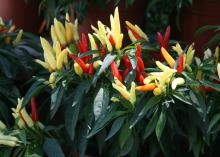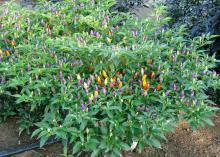Information Possibly Outdated
The information presented on this page was originally released on September 16, 2010. It may not be outdated, but please search our site for more current information. If you plan to quote or reference this information in a publication, please check with the Extension specialist or author before proceeding.
Ornamental vegetables perform landscape duty
After reading about ornamental vegetables several years ago, I became interested in expanding the selection of ornamental bedding plants in my landscape. Then I saw a planting of ornamental peppers.
I am a true “chili head” with a passion for hot peppers, and I have even made an apple and habanero wine. I have grown jalapeño, habanero and the like as bedding plants, as many of the extremely hot peppers produce very colorful fruit.
It’s only recently that I have grown the true ornamental-type peppers. They come in a variety of sizes, and some have green-purple foliage or multicolored fruit. Ornamental peppers are a unique way to add interest to your garden.
A desirable trait of these ornamental peppers is the delightfully colored fruit that most hold upright above the foliage. It is as if the plant is saying, “Hey, look at my gorgeous fruit.”
Seeds are available at many online seed houses, but it is too late to start with seeds for this season. Instead, find containerized plants in full fruit at your favorite garden center.
Ornamental peppers also make outstanding houseplants, especially the dwarf varieties. They thrive in a well-lit window. Because they hold their fruit for extended periods, they can make good holiday plants. Some are being promoted for this very reason. Why celebrate with a poinsettia when you can celebrate with a poinsettia ornamental pepper?
Purple Flash, a Mississippi Medallion winner for 2010, is an example of the versatility and value of ornamental peppers. Here are a couple of my landscape favorites:
Chilly Chili seems to explode in a dramatic, colorful demonstration. The fruit, which are held above the foliage, start as yellow green and transition to bright orange and brilliant red. Plants grow 1 foot tall and wide, making Chilly Chili a great choice for container planting. This plant will tolerate our hot, humid Mississippi summers and have great color when other plants are fading. The peppers are not too pungent, making this variety one of the safest to grow around children.
NuMex Twilight is a versatile plant. It grows well in containers, where it will reach 12 inches tall, but it can reach 30 inches tall when planted in the landscape. It is useful as a colorful, small landscape hedge. The piquin-type peppers start off purple and ripen to yellow, orange and red. All four colors are present at any given time, especially in late summer and fall.
When the pepper plants are producing, it is very common to have peppers in various stages of coloration. This is a fantastic feature that provides an ever-changing look in the landscape. Once fruit has set, it is common for the fruit to remain on the plant for a few months, maintaining the beautiful colors. Colors start to fade when the fruit begins to dry.
Ornamental peppers like consistently moist soil and will not tolerate water-logged soil. Fertilize with a good, slow-release fertilizer early in the season. Once fruit starts to set, there is no need to add additional nutrition.
A word of caution: although most of these ornamental peppers are edible, they are extremely hot. Take care to keep curious youngsters from trying to eat the brightly colored fruit.









